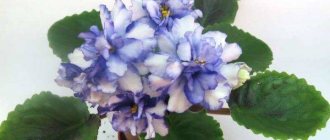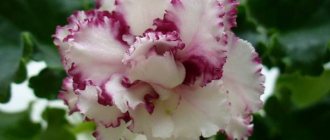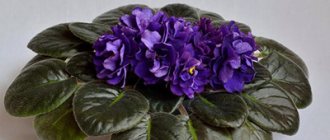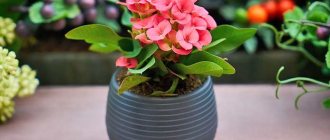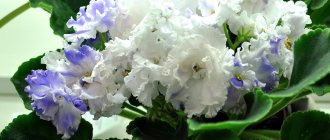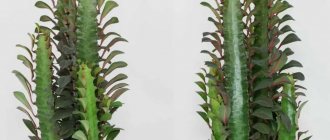Violets are very popular and sought-after indoor plants. With their decorativeness and variety of species and varieties, they captivate the hearts of flower growers.
Breeders managed to develop many forms and colors of this unique crop.
In this article I would like to talk about unusual varieties of green violets (Saintpaulias) and some secrets of caring for them.
After all, an important element of successfully growing a plant you like is studying its characteristics, and the experience of other gardeners helps a lot in this direction.
Top 10 most popular varieties
EK-Green Apples
A special feature of this variety are dense double flowers with light green outer petals. The center of the flower is blue.
The leaves are dark green. In cool conditions, the flower shows its shades more vividly.
PC-Green Corals
It features simple blue and white stars bordered by a bright green border.
The foliage of this purple variety is wavy, shiny, and medium green in color. Large leaves are often gnarled. Due to the dense and twisted foliage, the rosette cannot acquire a beautiful shape.
The flowers are dense, of an unusual ultramarine color. The edges of the petals are framed by a gray border. The shade of the petals and the edge of the flower can be of different saturation.
The process of flowering buds takes a long time, some of them do not have time to fully bloom. Flowering lasts about a month.
Attention! The plant does not bloom frequently or abundantly. Small flowers look lonely next to very large leaves.
AB-Cupid
A showy variety with single or semi-double white pansies, with a slight pinkish tint and a bright green wavy edge.
The foliage is quite large, shiny, sparkling, medium green in color; in high temperatures, a pink tint appears on the white petals of the flower.
Violet is characterized by abundant and long-lasting flowering. Many medium-sized flowers on strong and stable peduncles cover the plant with a “hat”.
This variety is distinguished by its unpretentiousness and fertility.
Fronzen in Time
An incredibly delicate variety with cupped white flowers resembling stars, bordered by a rich green border.
The plant is valued for its long flowering. The flowers sometimes take on a pale lilac color.
The foliage is variegated, green and white.
EK-Malachite orchid
Its large double flowers are rich cherry color with a wide green border around the edges.
When exposed to low ambient temperatures, the purple color turns almost completely green, leaving only the center of the cherry.
The rosette leaves have a pointed shape. The flowering period is approximately 3 months. Gems are usually collected in bunches.
The variety is characterized by intensive and unpretentious growth.
LE-Green Rose
The flowers of this variety resemble pansies, are colored soft pink and are framed by a green fringe along the edges of the petals. The foliage has a wavy shape and a glossy shine.
The border is green only when the buds open, then when the flower opens it turns yellow, and then completely loses color, becoming white.
Flower bouquet. Does not have a long flowering period. Fast growing variety.
Green Horizon
The flowers of this variety of Saintpaulia are double white stars with wide green stripes along the edges of the petals. Medium green foliage.
The saturation of green color in the petals of the bud manifests itself with the age of the rosette: the older it is, the larger and richer the flowers appear.
Important! This green and white purple plant boasts profuse and long-lasting blooms, fast growth and ease of propagation.
Allegro Pink Pistachio
A chic semi-miniature variety with green double roses framed by a crimson-red frill.
The foliage is light green in color, has a glossy surface and an elongated shape.
Flowering is almost continuous. A unique and incomparable variety.
RS-Miracle Lily of the Valley
The flowers of this variety of violets delight with their simplicity and tenderness.
They are bell-shaped, pink in color, with light green fringe along the edges of the petals. The bud never fully opens, hence the resemblance to a thrush.
The foliage is standard, light green. Flowering is long and abundant.
AB-Frog
The flower is similar to a pansy, semi-double, wavy, blue-white with a blue border and green upper petals.
The leaves are round, with jagged edges. The combination of colors in the bud looks very impressive.
Flowering is abundant and long lasting.
Use of color in advertising
Purple with yellow or gold is used in advertising to attract the attention of creative audiences. In addition, shades of purple can be found on the packaging of products that contain components of this color, for example, purple flowers or berries. Purple is often used in advertising of luxury goods in order to emphasize their significance and uniqueness. In advertising of esoteric services, purple acts as a symbol of self-knowledge. The lilac shade goes very well with pink, which is traditionally considered girly and is therefore used in advertising for girls' products and products intended for child care. Purple and lilac can be seen in commercials for women's perfumes and perfumes. These shades look most advantageous in glass, which gives them special depth and tenderness.
Features of care
Green violet varieties are considered more demanding on storage conditions than others. This is due to the fact that their color characteristics are directly related to temperature, lighting conditions and regularity of watering.
In general, violets with green flowers are considered not very demanding plants; the main thing is to follow the basic recommendations for caring for them.
However, among these Saintpaulias one can distinguish green violets, which can be difficult to grow:
- LE-green rose;
- RS-Laguna Verde;
- Green Dragon;
- Green corals RS.
Watering
The watering regime is no different from the norms recommended for other varieties of Saintpaulia. It is important to water the plants with boiled water at room temperature.
Do not allow the soil to overflow or, conversely, dry out. Overmoistening of the soil can lead to the development of fungal diseases of the plant root system.
Violets cannot be poured or dried.
In addition, it is recommended to water at the root of the bush, without leaving a drop of water on the surface of the leaves, or to use the wick method of watering.
Air humidity
Increased air humidity will promote regular flowering. You can create it by placing a flower pot on an expanded clay tray filled with water.
Lighting
Most green violets require bright lighting due to their dark, dark green foliage.
Those varieties that have a lighter leaf part are able to grow in more shady conditions.
The most convenient place for placing green violets is considered to be an eastern or western window.
Advice! To ensure uniform formation of the rosette, it is necessary to periodically turn the pot with the plant over.
Optimal temperature
The most important criterion affecting the appearance and saturation of green color in Saintpaulia flowers is the temperature regime.
To develop a green tint, purple must create conditions of a comfortable temperature, no higher than 20 degrees. As it increases, the green color becomes less noticeable and subsequently disappears completely.
Feeding
Most green violets have wavy foliage, a sign of slow growing plants. Therefore, nitrogen fertilizers must be regular and balanced. In addition, it is recommended to ensure that the soil acidity level is close to neutral.
Characteristics and cultivation
Saintpaulia (the second name for violets) is a small rhizomatous plant that does not reach more than 30 cm. Thanks to various hybrids, the inflorescences can be of any color, although the most characteristic color for this plant is the one that gives it its name. The rosettes are usually simple, the flowers can grow isolated or collected in inflorescences, but they always have five petals.
Variety of indoor violets
Saintpaulia is a plant that needs a lot of water, so it needs to be watered two to three times a week to keep the substrate moist. In addition, it is very important that there is a good drainage layer at the bottom of the pot. As much as possible, it is recommended to avoid direct use of tap water as chlorine is harmful. It is also not recommended to water at night, as low temperatures may damage the hairs covering the plant.
For your information! The first hours of the morning are best for watering.
If the leaves are dusty, they should not be wiped with a cloth, as they are easily damaged. The best option would be to spray warm water so that the dust simply drains away along with any remaining moisture.
Violets prefer shade rather than direct sunlight.
Growing violets
Classification by leaves
Hydrangea paniculata white, red, pink - the best winter-hardy varieties
Few people know that the color of violet inflorescences and leaves is inherited together, since this is influenced by its genetically linked characteristics. Varieties with almost black leaves have a burgundy or purple flower color, and those with light leaves have white flowers.
But sometimes hybrids appear that stand out from the crowd and attract attention. They look extremely impressive
Light Frost and Orchard's Night Light have an almost black rosette and white inflorescences. There are also varieties with white leaves.
Varieties of violets with names can puzzle even the most experienced gardener. In some cases, a description of leaf color can help identify the plant variety.
Collectors rarely pay serious attention to the coloring of the reverse side of the sheet, but breeders never make such an oversight. Only a small number of plants have silver, pink or red undersides
Typically, silver-green is characteristic of plants with white and pink flowers, and the red back is characteristic of purple and burgundy varieties.
Unusual violet leaves
Speaking about colors, it is worth mentioning the variegated color and its variants. The variegated mutation is valued for its decorative properties. In this case, abnormal groups appear among normal cells that lack green pigment. Variegation comes in different types: in the form of spots, stripes or streaks.
In any case, all violets are worthy of attention and detailed description, but within the scope of this article a superficial introduction is sufficient. Each variety has unique characteristics, so any gardener will choose a suitable specimen for himself, and maybe several at once for his collection.
What are chimera violets called?
The concept of "chimera" is known as a monster from ancient Greek mythology. It had an unusual appearance - it had the head of a lion, the body of a goat, and the tail of a dragon. From a biological point of view, this creature had three groups of cellular tissue, each with its own genetic characteristics. Since it is difficult to believe in the existence of such an organism, fantasy began to be called a chimera.
What does a chimera have to do with a houseplant? The fact is that this is the name given to those varieties of violets in which the cells of several varieties of violets are combined together. However, they do not mix. Each petal consists of several genetic layers. They differ from each other in color. The main layer is the background one, and the additional one gives the petal a different shade, such as a spot or stripe. In a cross section, this property is clearly visible.
Chimera violets are divided into two large groups according to color type:
- with direct coloration, the petals are light in color in contrast to the central stripe;
- in reverse-colored chimeras, the central stripe is lighter than the main layer.
However, there is another variety of violets - leaf chimeras.
The color of the petals has no peculiarities, but the leaf blade has a white stripe that runs through it, contrasting with the green background. Sometimes the white color appears as dots or has a yellow tint.
Who likes the color purple?
The main quality of people who choose purple as their favorite color is inconsistency; there is always an internal conflict in them. They are not like everyone else and see the surrounding reality in their own way. Their personality is multifaceted and combines impressionability with self-confidence. Such people are attracted to more subtle matters, attracted by everything mysterious, and have little interest in material things.
Important! More often than not, people who prefer purple to all other colors find it difficult to realize themselves in life, both personal and professional. Pedants, passionate inside, but outwardly more often behave with restraint
They are prone to melancholy, prone to depression, and acutely perceive negative moments that happen in the world around them. These are humanists and fighters for justice who do not find it in real life. Because of this, “purple” people often withdraw into themselves, and from the outside they can look gloomy and even embittered. They prefer loneliness, are prone to self-examination and, through introspection, discover new facets of their “I”. Such people constantly seem to evaluate themselves from the outside
Pedants are passionate on the inside, but outwardly they often behave with restraint. They are prone to melancholy, prone to depression, and acutely perceive negative moments that happen in the world around them. These are humanists and fighters for justice who do not find it in real life. Because of this, “purple” people often withdraw into themselves, and from the outside they can look gloomy and even embittered. They prefer loneliness, are prone to self-examination and, through introspection, discover new facets of their “I”. Such people constantly seem to evaluate themselves from the outside.
“Purple” people are sensitive and modest, they will never offend the weak and will not refuse help. Wise, but at the same time easily susceptible to other people's influence, driven and trusting. Lovers of purple avoid arguments and do not prove their point of view, but in a critical situation they are able to defend their opinion.
The main traits of “purple” people:
– phlegmatic character; – pessimism; - daydreaming; – soul-searching, increased interest in the inner world; – excessive self-control; – heightened sensitivity and vulnerability, touchiness; – softness and pliability; - kindness and caring.
In addition, people who prefer a purple tint are most often childish and internally immature; it is not for nothing that teenagers are partial to the color purple.
Saintpaulias with lilac border
The most exotic varieties with a lilac border are Ever Precious and Jan Menuet.
Ever Precious
This is a variety of white violet with a purple border. Its leaves are green and slightly wavy, glossy to the touch. 5-6 buds are formed on the flower stalks of the plant.
Ever Precious blooms 6 buds
Jan Menuet
This ornamental bush has rather large flowers that resemble stars. Their size can be up to 7 cm. The combination of pink flowers with lilac fringe makes violets a frequent item in the collection of many gardeners. Up to 3 buds can appear on each strong peduncle. The leaves of the plant are dark green, jagged, and have a slightly wavy shape.
In fact, there are many more varieties of Saintpaulia. Those discussed above are the most famous representatives of the family. They can decorate any room. Beautiful and varied flowers will be a wonderful decoration for any home.
Men
Intellectuals with a keen eye for observation. In life they notice more negative things, that is, they think in a pessimistic way. They are kind, understanding, but do not like to give advice, because they believe that a person should be responsible for himself and decide what to do. They love independence in everything, so they set the rules by which they live themselves. Men who prefer purple are aesthetes by nature. Although they may come across as vain and arrogant, they usually are not. They rarely say what they think, but their facial expressions reveal their true thoughts.
Saintpaulias with lilac border
The most exotic varieties with a lilac border are Ever Precious and Jan Menuet.
Ever Precious
This is a variety of white violet with a purple border. Its leaves are green and slightly wavy, glossy to the touch. 5-6 buds are formed on the flower stalks of the plant.
Ever Precious blooms 6 buds
Jan Menuet
This ornamental bush has rather large flowers that resemble stars. Their size can be up to 7 cm. The combination of pink flowers with lilac fringe makes violets a frequent item in the collection of many gardeners. Up to 3 buds can appear on each strong peduncle. The leaves of the plant are dark green, jagged, and have a slightly wavy shape.
In fact, there are many more varieties of Saintpaulia. Those discussed above are the most famous representatives of the family. They can decorate any room. Beautiful and varied flowers will be a wonderful decoration for any home.
Cyclamen: poisonous or not
For some gardeners, cyclamen is important as a home flower. They grow it in pots on windowsills, so it is quite reasonable that many people have a question: is cyclamen poisonous? Experienced gardeners talk about it as an ornamental plant that combines poisonous and healing properties. For example, it contains a substance such as cyclamine, which in its pure form is very toxic. Cyclomeretin is obtained from it, used in folk medicine to treat runny nose, sinusitis, and gastrointestinal disorders.
Attention! For medicinal purposes, the plant is used exclusively under medical supervision. There should be no self-medication
Pink marshmallow
Violets of this variety are distinguished by variegated rosettes, lush flowers, double appearance, and very bright (light crimson) color of the petals. The species was bred by Lebetskaya. It is quite rare, but very beautiful. Terry stars look like a plentiful, lush cap above the leaves. The leaves are even, variegated - with a delicate white border along the edge of the dark green leaf. One flower reaches 5-6 centimeters, the whole plant looks compact.
Zephyr has very strong peduncles that stand upright. The flowers are light when they first bloom and darken over time. The maximum diameter is six and a half centimeters. Saintpaulia of this variety looks classic, without play or multicolor, and the variegation of the leaves adds elegance to it.
Young foliage can be very light. In general, Zephyr can be quite different under different conditions. Brightness is primarily affected by lighting, which is why Marshmallow often turns out pale and tender. These flowers look more like small roses than violets. Zephyr blooms a lot of foliage, but it does not interfere with the growth of flowers, but, on the contrary, emphasizes the colors. In the first flowering, doubleness may not appear. Saturation is added as one blooms - from beginning to end.
Saintpaulias with green border
Flowers with a green border are no less interesting.
Blue Dragon
The variety is quite famous among gardeners. It gained its popularity thanks to its bright blue buds. There is a greenish border at the edges of the petals. This plant is quite finicky to care for, as it needs a constant natural source of light.
Water
This purple violet with a voluminous green border is very difficult to grow. If improperly watered, it may die. Flowers and leaves have bizarre curving shapes. The buds are located on powerful peduncles of 3 or 5 pieces. When in full bloom they can reach 5 cm in diameter.
The Vodyanoy variety is very demanding when it comes to watering.
Stone Flower
A rather unusual red violet with petals framed by a soft green fringe. The leaves are large, wavy, and have a dark green tint. This species takes quite a long time to grow. In general, the plant is very capricious, and in order to wait for the moment when the buds appear and bloom, you will need to try very hard. But if you have enough patience and all the efforts are made correctly, the result will be a bush of amazing beauty.
Violet in the house: what do folk signs say?
Usambara Saintpaulia is one of the most popular indoor plants.
Today, violets have been distributed throughout the world for a century. Since the Usambara Saintpaulia was brought to the Old World straight from the mountains of East Africa. During this time, the flower managed to acquire signs and superstitions. They are based on personal observations and subjective analysis:
- In the East, violet is considered a flower whose presence in the house is always welcome. A modest plant on the windowsill protects peace and harmony in the family and helps members of the house build good relationships with each other. And with those around you!
- But for people with negative thoughts, the violets do not linger - they die instantly, one after another.
Varieties of violets with variegated leaves have been developed
- There is another “reason” that the recently thriving Uzambara Saintpaulia suddenly dies. There is a superstition that the flower “takes away the disease” of its owner, maintaining his health. On my own behalf, as a skeptic, I would like to note: the statement is very controversial. According to my observations, much more often the reason lies in improper care: 90% of violets disappear due to rot of the root system, which is to blame for excessive watering.
- In the West they say that violets “soothe the heart.” They help people become softer and more attentive to their neighbors, absorbing their aggression. At the same time, Saintpaulia is a very delicate flower, and in the same house with an ardent aggressor it grows reluctantly and refuses to bloom.
There are also negative signs associated with Saintpaulias. For example, that they prevent girls from getting married or attract grief. I know many people who are happy in marriage and in other areas of life, who grow violets and even have an impressive collection of Uzambar Saintpaulias, about 400 varieties.
So you shouldn’t listen to negative information - in the end, we ourselves choose what to believe in and attract it into our lives. I advise you to think about the positive!
Saintpaulia color scheme
In its natural habitat, the crop does not differ in any special appearance: the buds are not as bright as those of their decorative counterparts, and the leaves are less lush and of a different shape. A wide variety of colors was achieved through selective means. The violet with red flowers was first bred in 1898, with double flowers in 1939, with white flowers in 1940, and only in 1942 was it possible to create a hybrid with pink flowers. This event was so significant for botanists that the resulting hybrid was named Tommy Lowe in honor of the creator T. Louise Auden.
Variety Georgia
For your information! The plant was known 2000 years ago. The ancient Greeks and Romans decorated the statues of their gods with wreaths woven from violets.
Modern house plants only vaguely resemble their ancestor from tropical latitudes. They differ in the size of the rosettes, some with a diameter of up to 50 cm. There is also a difference in the size and volume of the flowers, the shape and color of the leaves and, of course, a wide variety of colors. Violets can have flowers of various shades, except yellow. Although white and pink varieties with yellow veins are known. Breeders have not yet succeeded in breeding lemon-colored Saintpaulia. But even without it, gardeners have a wide choice.
Note! The final saturation of the violet’s shade is achieved only after 3-4 years of life. Therefore, you should not be surprised that it changes color over time.
